Smart Modulators Based on Electric Field-Triggering of Surface Plasmon–Polariton for Active Plasmonics
Abstract
1. Introduction
2. Experimental Methods
2.1. Materials
2.2. Sample Preparation
2.3. Measurement Techniques
3. Results and Discussion
4. Conclusions
Author Contributions
Funding
Data Availability Statement
Conflicts of Interest
References
- de Angelis, B.; Depalo, N.; Petronella, F.; Quinarelli, C.; Curri, L.M.; Pani, R.; Calogero, A.; Locatelli, F.; de Sio, L. Stimuli-responsive nanoparticle-assisted immunotherapy: A new weapon against solid tumours. J. Mater. Chem. B 2020, 8, 1823–1840. [Google Scholar] [CrossRef] [PubMed]
- Kalachyova, Y.; Guselnikova, O.; Elashnikov, R.; Panov, I.; Žádný, J.; Církva, V.; Storch, J.; Sykora, J.; Zaruba, K.; Svorcik, V.; et al. Helicene-SPP-based chiral plasmonic hybrid structure: Toward direct enantiomers SERS discrimination. ACS Appl. Mater. Interfac. 2018, 11, 1555–1562. [Google Scholar] [CrossRef] [PubMed]
- Ren, H.; Maier, S.A. Nanophotonic Materials for Twisted-Light Manipulation. Adv. Mater. 2021, 2106692. [Google Scholar] [CrossRef]
- Ahmadivand, A.; Gerislioglu, B. Photonic and Plasmonic Metasensors. Laser Photon. Rev. 2022, 16, 2100328. [Google Scholar] [CrossRef]
- Zabelin, D.; Zabelina, A.; Tulupova, A.; Elashnikov, R.; Kolska, Z.; Svorcik, V.; Lyutakov, O. A surface plasmon polariton-triggered Z-scheme for overall water splitting and solely light-induced hydrogen generation. J. Mat. Chem. A 2022, 10, 13829–13838. [Google Scholar] [CrossRef]
- Ha, M.; Kim, J.H.; You, M.; Li, Q.; Fan, C.; Nam, J.M. Multicomponent plasmonic nanoparticles: From heterostructured nanoparticles to colloidal composite nanostructures. Chem. Rev. 2019, 119, 12208–12278. [Google Scholar] [CrossRef] [PubMed]
- Wang, L.; Kafshgari, M.H.; Meunier, M. Optical properties and applications of plasmonic-metal nanoparticles. Adv. Funct. Mater. 2020, 30, 2005400. [Google Scholar] [CrossRef]
- Lütolf, F.; Casari, D.; Gallinet, B. Low-Cost and Large-Area Strain Sensors Based on Plasmonic Fano Resonances. Adv. Opt. Mater. 2016, 4, 715–721. [Google Scholar] [CrossRef]
- Wen, J.; Zhang, H.; Chen, H.; Zhang, W.; Chen, J. Stretchable Plasmonic Substrate with Tunable Resonances for Surface-Enhanced Raman Spectroscopy. J. Opt. 2015, 11, 114015. [Google Scholar] [CrossRef]
- Ahn, J.; Wang, D.; Ding, Y.; Zhang, J.; Qin, D. Site-selective carving and Co-deposition: Transformation of Ag nanocubes into concave nanocrystals encased by Au–Ag alloy frames. ACS Nano 2018, 12, 298–307. [Google Scholar] [CrossRef]
- Liu, N.L.; Duan, X.Y.; Kamin, S. Dynamic Plasmonic Colour Display. Nat. Commun. 2017, 8, 14606. [Google Scholar]
- Kowerdziej, R.; Wróbel, J.; Kula, P. Ultrafast electrical switching of nanostructured metadevice with dual-frequency liquid crystal. Sci. Rep. 2019, 9, 20367. [Google Scholar] [CrossRef] [PubMed]
- Hang, Y.; Boryczka, J.; Wu, N. Visible-light and near-infrared fluorescence and surface-enhanced Raman scattering point-of-care sensing and bio-imaging: A review. Chem. Soc. Rev. 2022, 51, 329–375. [Google Scholar] [PubMed]
- Olshtrem, A.; Guselnikova, O.; Postnikov, P.S.; Trelin, A.; Yusubov, M.S.; Kalachyova, Y.; Lapcak, L.; Cieslar, M.; Ulbrich, P.; Lyutakov, O. Plasmon-assisted grafting of anisotropic nanoparticles–spatially selective surface modification and creation of amphiphilic SERS-nanoprobes. Nanoscale 2020, 12, 14581–14588. [Google Scholar] [CrossRef]
- Laible, F.; Horneber, A.; Fleischer, M. Mechanically Tunable Nanogap Antennas: Single-Structure Effects and Multi-Structure Applications. Adv. Opt. Mater. 2021, 9, 2100326. [Google Scholar] [CrossRef]
- Tokarev, I.; Minko, S. Tunable Plasmonic Nanostructures from Noble Metal Nanoparticles and Stimuli-Responsive Polymers. Soft Matter 2012, 8, 5980–5987. [Google Scholar] [CrossRef]
- Lacroix, J.-C.; van Nguyen, Q.; Ai, Y.; van Nguyen, Q.; Martin, P.; Lacaze, P.-C. From active plasmonic devices to plasmonic molecular electronics. Polym. Int. 2019, 68, 607–619. [Google Scholar] [CrossRef]
- Liang, L.; Lam, S.H.; Ma, L.; Lu, W.; Wang, S.B.; Chen, A.; Wang, J.; Shao, L.; Jiang, N.; Jiang, N. (Gold nanorod core)/(poly (3, 4-ethylene-dioxythiophene) shell) nanostructures and their monolayer arrays for plasmonic switching. Nanoscale 2020, 12, 20684–20692. [Google Scholar] [CrossRef]
- Stockhausen, V.; Martin, P.; Ghilane, J.; Leroux, Y.; Randriamahazaka, H.; Grand, J.; Felidj, N.; Lacroix, J.C. Giant Plasmon Resonance Shift Using Poly(3,4- ethylenedioxythiophene) Electrochemical Switching. J. Am. Chem. Soc. 2010, 132, 10224–10226. [Google Scholar] [CrossRef]
- Ding, T.; Rüttiger, C.; Zheng, X.; Benz, F.; Ohadi, H.; Vandenbosch, G.A.; Moshchalkov, V.; Gallei, M.; Baumberg, J.J. Fast Dynamic Color Switching in Temperature-Responsive Plasmonic Films. Adv. Opt. Mater. 2016, 4, 877–882. [Google Scholar] [CrossRef]
- Lapsley, I.M.; Shahravan, A.; Hao, Q.; Giardinelli, J.B.K.S.; Lu, M.; Zhao, Y.; Chiang, I.K.; Matsoukas, T.; Huang, T.J. Shifts in Plasmon Resonance due to Charging of a Nanodisk Array in Argon Plasma. Appl. Phys. Lett. 2012, 100, 101903. [Google Scholar] [CrossRef] [PubMed]
- Wang, Y.; Liu, L.; Wang, Q.; Han, W.; Lu, M.; Dong, L. Strain-Tunable Plasmonic Crystal Using Elevated Nanodisks with Polarization-Dependent Characteristics. Appl. Phys. Lett. 2016, 108, 071110. [Google Scholar] [CrossRef]
- Güell-Grau, P.; Pi, F.; Villa, R.; Eskilson, O.; Aili, D.; Nogués, J.; Sepulveda, B.; Alvarez, M. Elastic Plasmonic-Enhanced Fabry–Pérot Cavities with Ultrasensitive Stretching Tunability. Adv. Mater. 2022, 37, 2106731. [Google Scholar] [CrossRef] [PubMed]
- Song, M.; Wang, D.; Peana, S.; Choudhury, S.; Nyga, P.; Kudyshev, Z.A.; Yu, H.; Boltasseva, A.; Shalaev, C.M.; Kildishev, A.V. Colors with plasmonic nanostructures: A full-spectrum review. Appl. Phys. Rev. 2019, 6, 041308. [Google Scholar] [CrossRef]
- Steiner, A.M.; Mayer, M.; Seuss, M.; Nikolov, S.; Harris, K.D.; Alexeev, A.; Kuttner, C.; Konig, T.A.F.; Fery, A. Macroscopic Strain-Induced Transition from Quasi-Infinite Gold Nanoparticle Chains to Defined Plasmonic Oligomers. ACS Nano 2017, 11, 8871–8880. [Google Scholar] [CrossRef]
- Böhm, M.; Uhlig, T.; Derenko, S.; Eng, L.M. Mechanical Tuning of Plasmon Resonances in Elastic, Two-Dimensional Gold-Nanorod Arrays. Opt. Mater. Express 2017, 7, 1882–1897. [Google Scholar] [CrossRef]
- Gaiser, P.; Binz, J.; Gompf, B.; Berrier, A.; Dressel, M. Tuning the Dielectric Properties of Metallic-Nanoparticle/Elastomer Composites by Strain. Nanoscale 2015, 7, 4566–4571. [Google Scholar] [CrossRef]
- Krajcar, R.; Siegel, J.; Slepička, P.; Fitl, P.; Švorčík, V. Silver nanowires prepared on PET structured by laser irradiation. Mater. Lett. 2014, 117, 184–187. [Google Scholar] [CrossRef]
- Slepicka, P.; Siegel, J.; Lyutakov, O.; Kasalkova, N.S.; Kolska, Z.; Bacakova, L.; Svorcik, V. Polymer nanostructures for bioapplications induced by laser treatment. Biotechnol. Adv. 2018, 36, 839–855. [Google Scholar] [CrossRef]
- Semerádtová, A.; Štofík, M.; Neděla, O.; Staněk, O.; Slepička, P.; Kolská, Z.; Malý, J. A simple approach for fabrication of optical affinity-based bioanalytical microsystem on polymeric PEN foils. Colloids Surf. B 2018, 165, 28–36. [Google Scholar] [CrossRef]
- Tavkhelidze, A.; Jangidze, L.; Taliashvili, Z.; Gorji, N.E. G-Doping-Based Metal-Semiconductor Junction. Coatings 2021, 11, 945. [Google Scholar] [CrossRef]
- Hsiao, H.H.; Chu, C.H.; Tsai, D.P. Fundamentals and applications of metasurfaces. Small Methods 2017, 1, 1600064. [Google Scholar] [CrossRef]
- Zhu, X.; Shi, L.; Liu, X.; Zi, J.; Wang, Z.A. Mechanically Tunable Plasmonic Structure Composed of a Monolayer Array of Metal-Capped Colloidal Spheres on an Elastomeric Substrate. Nano Res. 2010, 3, 807–812. [Google Scholar] [CrossRef]
- Liu, J.; He, H.; Xiao, D.; Yin, S.; Ji, W.; Jiang, S.; Luo, D.; Wang, B.; Liu, Y. Recent advances of plasmonic nanoparticles and their applications. Materials 2018, 11, 1833. [Google Scholar] [CrossRef]
- Maksymov, I.S.; Greentree, A.D. Acoustically Tunable Optical Transmission through a Subwavelength Hole with a Bubble. Phys. Rev. A 2017, 95, 033811. [Google Scholar] [CrossRef]
- Nishiyama, H.; Saito, Y. Electrostatically Tunable Plasmonic Devices Fabricated on Multi-Photon Polymerized Three-Dimensional Microsprings. Opt. Express 2016, 24, 637–644. [Google Scholar] [CrossRef]
- Svanda, J.; Kalachyova, Y.; Slepicka, P.; Svorcik, V.; Lyutakov, O. Smart Component for Switching of Plasmon Resonance by External Electric Field. Appl. Mater. Interfaces 2016, 8, 225–231. [Google Scholar] [CrossRef]
- Guselnikova, O.; Svanda, J.; Postnikov, P.; Kalachyova, Y.; Svorcik, V.; Lyutakov, O. Fast and Reproducible Wettability Switching on Functionalized PVDF/PMMA Surface Controlled by External Electric Field. Adv. Mater. Interfaces 2017, 4, 1600886. [Google Scholar] [CrossRef]
- Guselnikova, O.; Postnikov, P.; Chehimi, M.M.; Kalachyova, Y.; Svorcik, V.; Lyutakov, O. Surface Plasmon-Polariton: A Novel Way To Initiate Azide-Alkyne Cycloaddition. Langmuir 2019, 35, 2023–2032. [Google Scholar] [CrossRef]
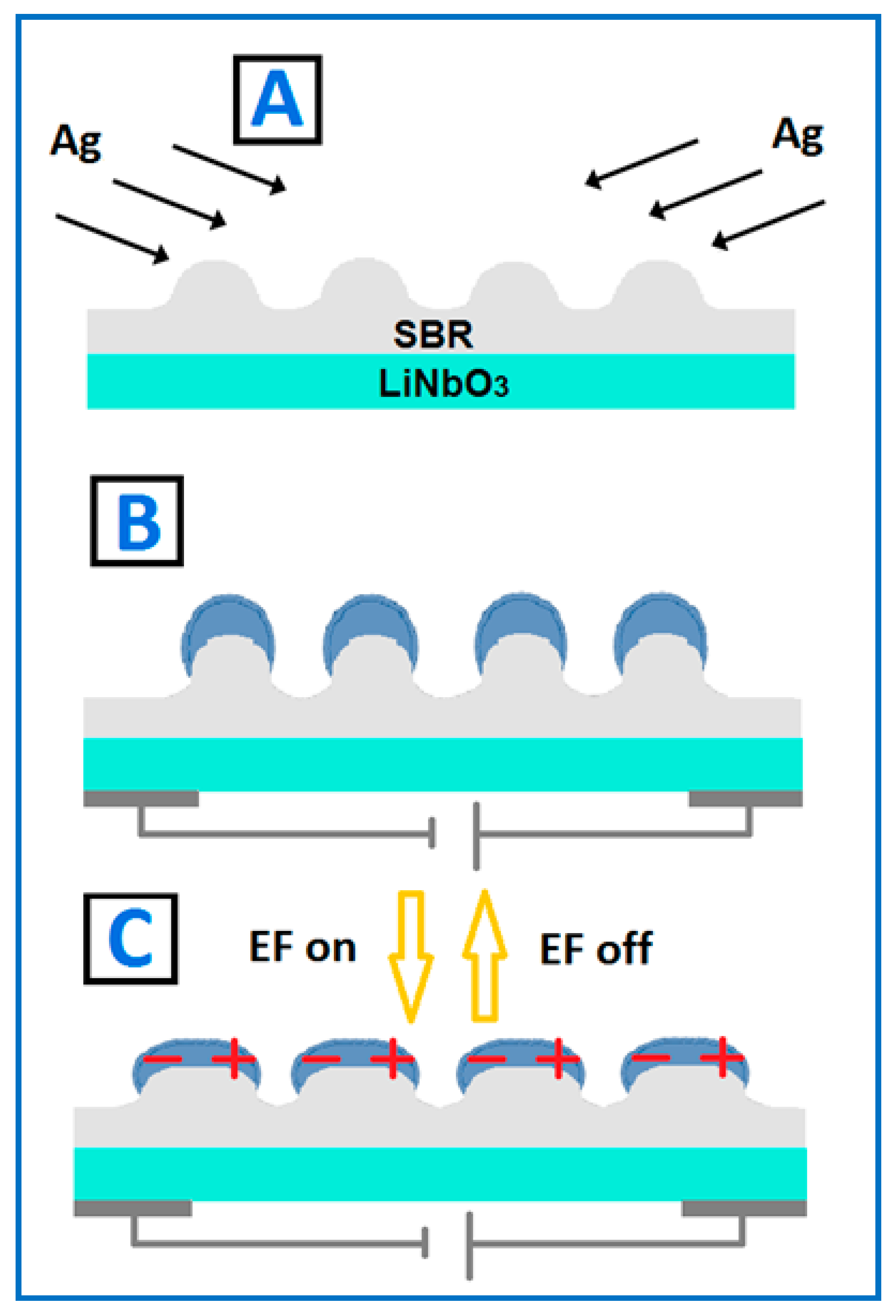
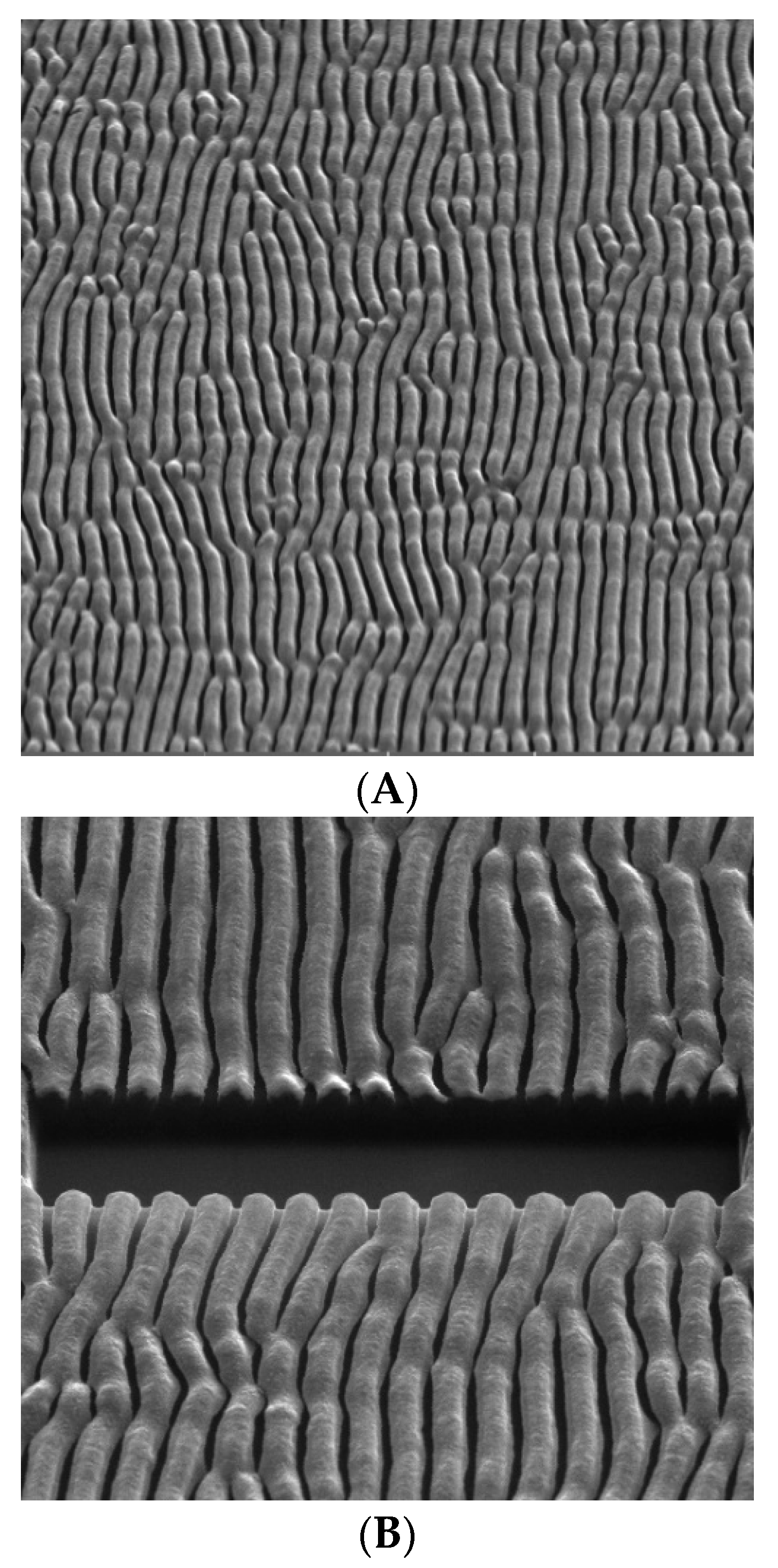

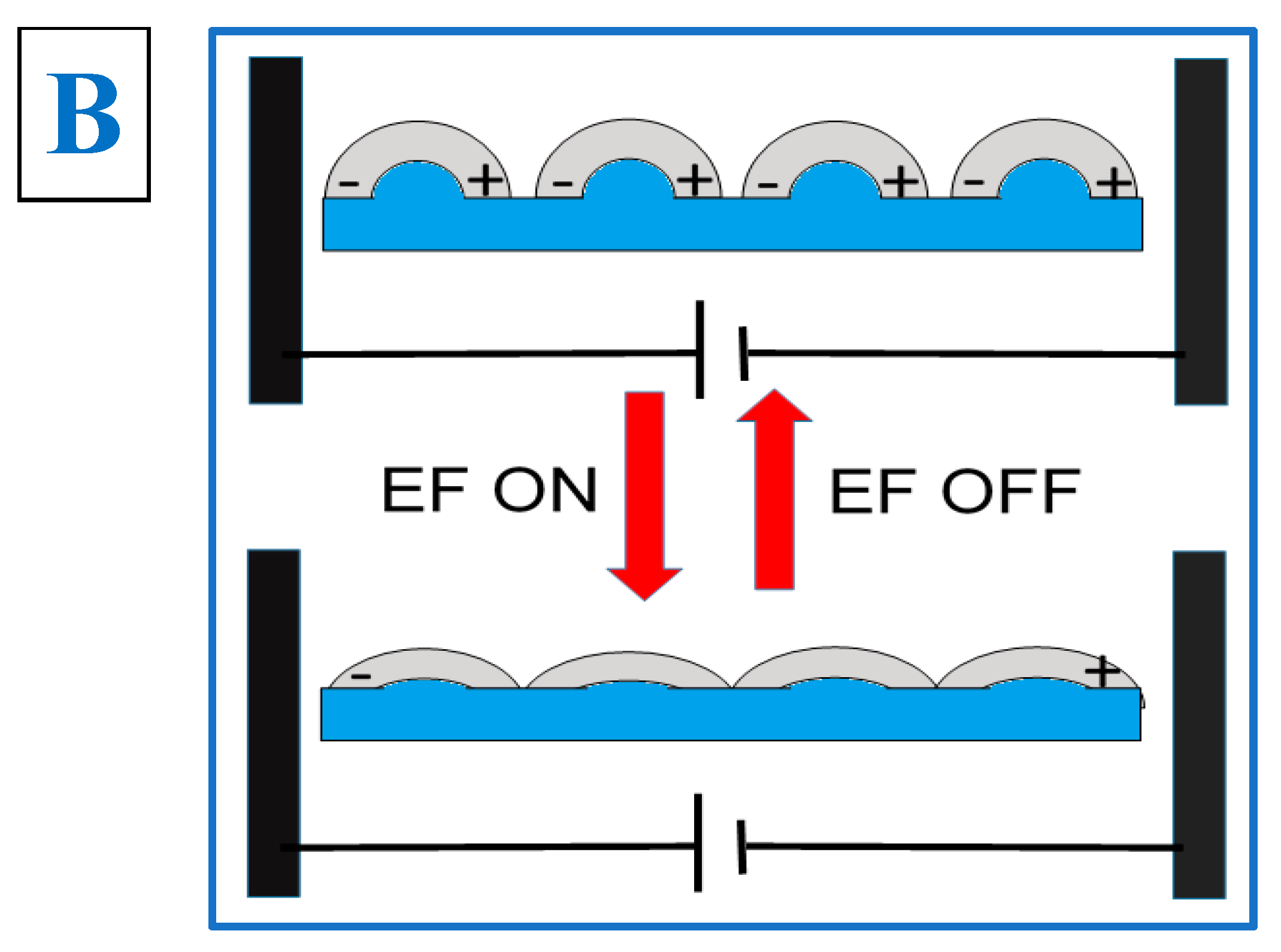
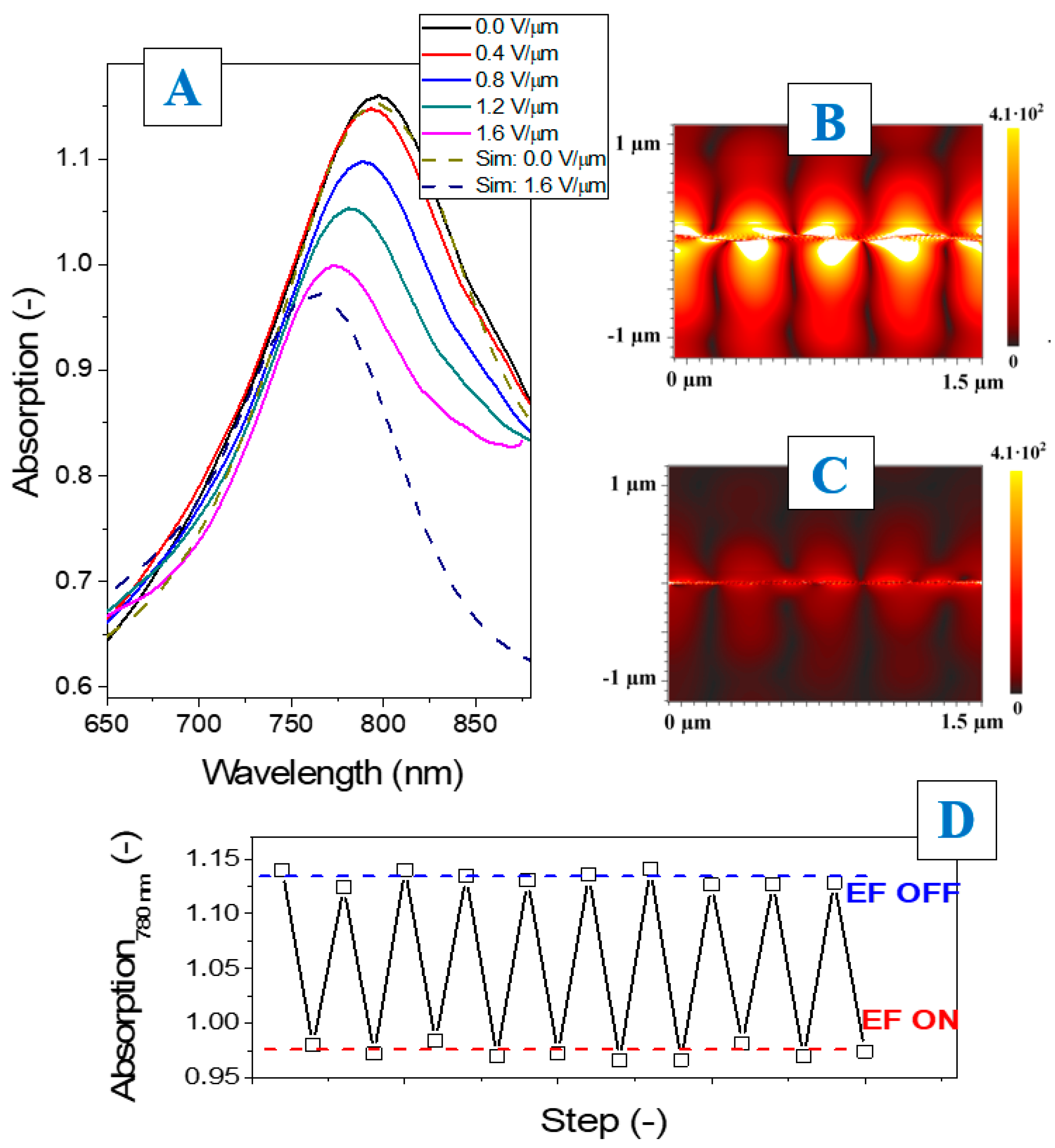
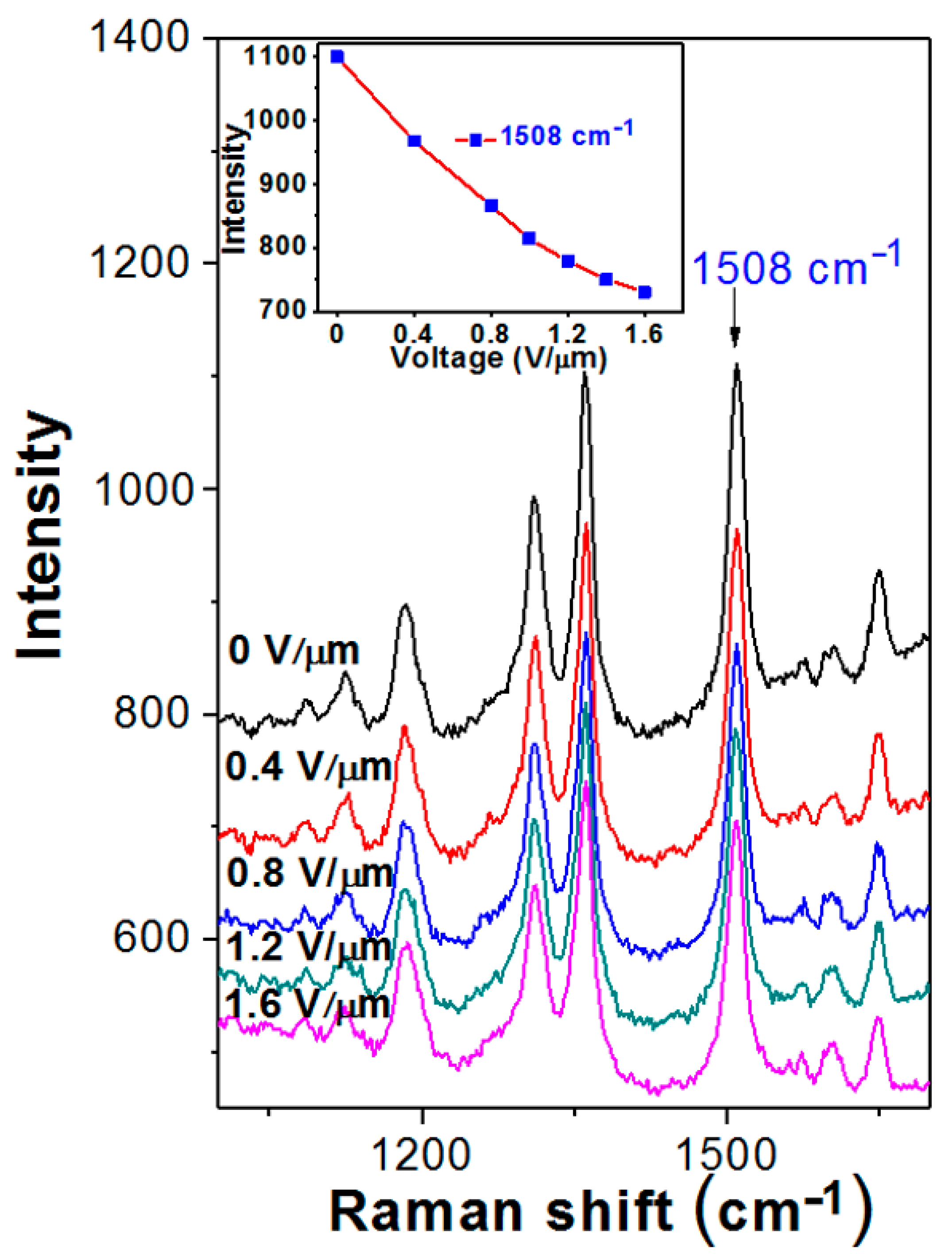
Publisher’s Note: MDPI stays neutral with regard to jurisdictional claims in published maps and institutional affiliations. |
© 2022 by the authors. Licensee MDPI, Basel, Switzerland. This article is an open access article distributed under the terms and conditions of the Creative Commons Attribution (CC BY) license (https://creativecommons.org/licenses/by/4.0/).
Share and Cite
Švanda, J.; Kalachyova, Y.; Mareš, D.; Siegel, J.; Slepička, P.; Kolská, Z.; Macháč, P.; Michna, Š.; Švorčík, V.; Lyutakov, O. Smart Modulators Based on Electric Field-Triggering of Surface Plasmon–Polariton for Active Plasmonics. Nanomaterials 2022, 12, 3366. https://doi.org/10.3390/nano12193366
Švanda J, Kalachyova Y, Mareš D, Siegel J, Slepička P, Kolská Z, Macháč P, Michna Š, Švorčík V, Lyutakov O. Smart Modulators Based on Electric Field-Triggering of Surface Plasmon–Polariton for Active Plasmonics. Nanomaterials. 2022; 12(19):3366. https://doi.org/10.3390/nano12193366
Chicago/Turabian StyleŠvanda, Jan, Yevgeniya Kalachyova, David Mareš, Jakub Siegel, Petr Slepička, Zdeňka Kolská, Petr Macháč, Štefan Michna, Václav Švorčík, and Oleksiy Lyutakov. 2022. "Smart Modulators Based on Electric Field-Triggering of Surface Plasmon–Polariton for Active Plasmonics" Nanomaterials 12, no. 19: 3366. https://doi.org/10.3390/nano12193366
APA StyleŠvanda, J., Kalachyova, Y., Mareš, D., Siegel, J., Slepička, P., Kolská, Z., Macháč, P., Michna, Š., Švorčík, V., & Lyutakov, O. (2022). Smart Modulators Based on Electric Field-Triggering of Surface Plasmon–Polariton for Active Plasmonics. Nanomaterials, 12(19), 3366. https://doi.org/10.3390/nano12193366






